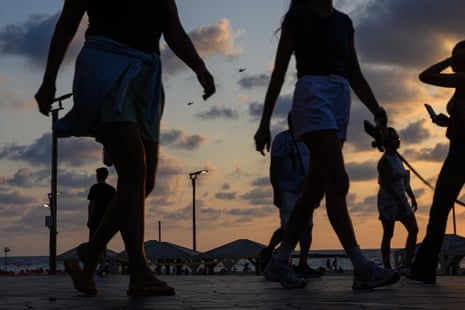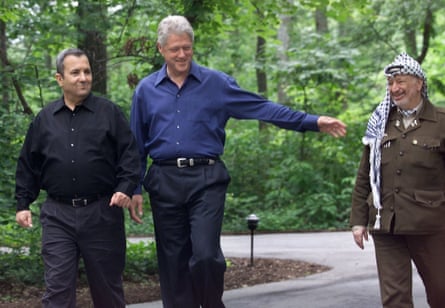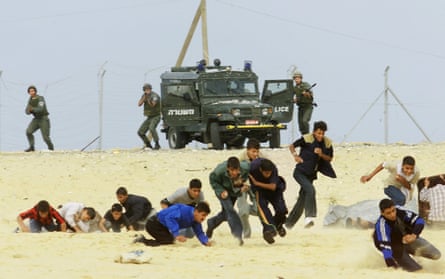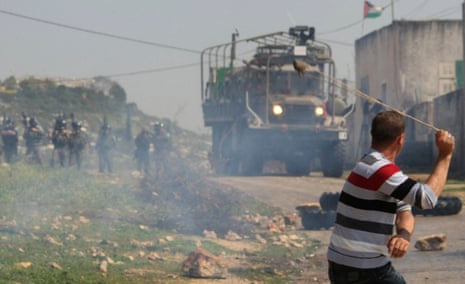
Throughout the two years of the Gaza war, Israeli bombing has been so intense that, in certain weather conditions, its echoes can be heard here in Tel Aviv, 70km away. The mass starvation is quieter. Even images of dead children rarely pierce Israel’s media bubble. The war appears in protests over the hostages, political debates, stickers with the faces of fallen soldiers on walls and bus stops. Palestinian suffering – by contrast – remains distant, abstract, unmoving.
After two years, Israeli society is adapting: the army has developed a practice of not calling reservists who are likely to dodge the draft; instead, it turns to former soldiers in need of cash or employment, offering them to fill the ranks of its combat units. At times, special arrangements are made so that reservists can keep working in their old jobs, practically doubling their income. Civilian contractors are hired to systematically raze whole neighborhoods in the Strip; they are paid by the house. The IDF is becoming a new military, adjusted for permanent operations in Gaza, the West Bank and the northern borders. The rest of the public goes on with their lives. War is the new normal.
In early August, Israel’s security cabinet ordered the military to occupy Gaza City, where some of Hamas’s leadership is supposedly hiding. The assault began with the toppling of high-rise buildings last week. Yet the term “occupation” is misleading: Israel has no intention of ruling over the more than 1 million Palestinians sheltering in the city. Emboldened by US support, the military has ordered residents to move to a so-called “humanitarian city” in the south, while Gaza City will be leveled to the ground. This would mark another step toward realizing the far-right fantasy of removing Palestinians from the territory altogether. Until then, they will remain crammed into a corner of the Strip, given only the bare minimum to keep them alive – and at times, not even that.
This week, several countries – among them France, the UK and Australia – intend to recognize the state of Palestine during the UN general assembly. Many people have long deemed the two-state solution dead, and nothing could seem further away from it than the dystopian reality on the ground. But the recognition is a sign of international engagement and a much-needed message for Israelis, who have moved into a creepy fantasy land: a recently leaked American-Israeli presentation, reportedly debated in the White House, imagines a new Gaza as a kind of futuristic theme park placed under US trusteeship and refashioned by international corporations into a glossy “Riviera of the Middle East” of smart cities, tourism and tech hubs.
Yet the real danger in Israel today is that nobody imagines a future at all: the society is locked in a permanent present. The war is unpopular, but enough are willing to serve it and only few are actively protesting against it. The liberal opposition movement and the protests over the hostages have morphed into each other, along with the pre-war domestic fights over the government’s plans to weaken the judiciary. Together, they have created a sense of never-ending crisis that Netanyahu and his coalition have managed to turn into an asset.

A recent poll found most people are not interested in getting more news from Gaza. The major networks broadcast cooking shows, reality TV and sports. Big Brother just had one of its most watched seasons, interrupted only for a brief moment when three anti-war protesters managed to storm the studio stage. “Everything is fine,” said the host. “Keep those votes coming in!”
At times, it seems as if confusion and frustration lie beneath the acceptance of the atrocities carried out in our name: a society that lost its way, is unsure how to end the war, fearful of the reckoning that awaits, and resorts to violent tantrums instead.
At other moments, a backward-looking narrative takes hold, one that is more coherent but also more perilous: what used to be political discourse on the conflict is giving way to a mythical language of victimization. It is a story in which 7 October 2023 is the continuation of the Holocaust, Hamas are the new Nazis, and the current war is our biblical retribution.
Signs for this old-new vocabulary are everywhere. It is common among Jews, for example, to add the initials for “blessed his memory” next to the name of the dead – but in this war, almost every soldier or civilian victim is memorialized with the phrase “Hashem yikom damo” (God will avenge his blood). Verses and quotes such as “I have pursued mine enemies and destroyed them” (2 Samuel 22:38) appear in military headquarters and battle orders; a calendar distributed by the military rabbinate early in the war placed the Gaza campaign on a mythical timeline that included David’s victory over Goliath and Israel’s occupation of the West Bank and Gaza in 1967.
This turn toward mythical thinking – the idea that Jews and Palestinians are locked in an eternal, zero-sum battle for the same land ֹ– dominates not just Israeli society, but much of the political thinking abroad. It obscures the more mundane reality that has enabled today’s carnage: a political system where one people rules and the other is ruled. It also narrows our political imagination, reducing the range of what is possible and fostering passivity precisely when action is most urgently needed.
Tomorrow Is Yesterday is the fitting title for a new book by two former negotiators and experts on the conflict. Hussein Agha and Robert Malley observe that the current war is not just a regression to a pre-peace process era decades ago. Nor is the systematic destruction of Gaza just a repetition of the Nakba, the Palestinian mass expulsion during Israel’s war of independence. There is something fundamental in both societies that looks into the past for political meaning, a core of their identity that surfaces now.
Malley, a key member of Bill Clinton’s Middle East negotiating team, is the son of an anti-Zionist Egyptian Jew who sympathized with the Palestinian cause and knew the Palestinian leader Yasser Arafat. As a young diplomat, Malley had been present at the Camp David summit in 2000, which was supposed to bring about a lasting Israeli-Palestinian peace deal, but ended up catalyzing the start of the second intifada 25 years ago this month. Later he served as Obama’s Middle East coordinator and as an envoy to the Iran nuclear talks. Agha, an intellectual of Iranian, Iraqi and Lebanese heritage who teaches at Oxford, was a longtime adviser to Arafat and Mahmoud Abbas, often operating as their envoy in formal and informal negotiations channels.
Their unique backgrounds – Hussein, who was viewed as Palestinian by choice rather than by heritage, and Malley’s anti-imperialist upbringing – often made the two a dissenting voice in diplomatic circles, insiders and outsiders at the same time. After the Camp David failure they challenged the dominant view, expressed by President Clinton and the senior members of his peace team, which placed all the blame for the failure on Arafat and the Palestinian side for not accepting “Israel’s generous offer”.

A year after the summit, in a much debated piece in the New York Review of Books, Malley and Agha pointed to the ways in which a deep-rooted American bias toward Israel led to poor preparation for the summit, unrealistic expectations and fundamental misunderstandings on all sides. To blame Palestinians alone, they warned, was not only unjust, but a recipe for disaster.
More than two decades later, the two have returned with a more radical diagnosis, shaped also by their experiences in subsequent talks. In Tomorrow Is Yesterday they argue the peace process was doomed from the start – not by tactical missteps or bad faith, though these existed in abundance, but because it fundamentally misunderstood the conflict itself.
The negotiations, Malley and Agha now write, attempted to suppress history itself, since what drives Israelis and Palestinians are not just tangible interests but existential longings rooted in history. For Jews, these flow from centuries of displacement and persecution, culminating in the Holocaust, and from what they call “the long, frustrated quest for a normal, recognized, and accepted homeland”. For many religious Israelis, this translates into a sacred claim over the entire land: Kol Israel (roughly, “all of Israel are responsible for one another”). These, rather than the liberal peace camp, are the deep, authentic voices driving the society.
For Palestinians, the core demands are equally elemental: to redress a history of dispossession and massacres, expulsion and dispersal, discrimination and denied dignity. Accepting Israel as a Jewish state is not, in this view, a pragmatic compromise but an intolerable “affront” – a move that would legitimize the very catastrophe that created their exile and retroactively criminalize their decades of struggle. Israelis seek something close to eternal security, which easily becomes eternal dominance; Palestinians want a return to a pre-Israel life that no longer exists.

The two-state solution, concludes the duo who devoted much of their life to reaching it, “is not the natural resting place for either Israelis or Palestinians [as] it runs counter to the essence of their national identities and aspirations”. The attempt to reach it was doomed because “both groups cannot accept a definitive closure”, since “neither is prepared to relinquish otherworldly dreams for the sake of an earthly understanding”.
What emerged was an artificial process, sustained through bias and denial. By privileging Israel and suppressing Palestinian claims, ignoring more radical or religious stakeholders, and prioritizing security over justice, US-led diplomacy built not peace but a pressure cooker. It blew up on 7 October.
Malley and Agha’s account is clear-eyed and unsparing, rejecting the very conventions that upheld the imbalance at the heart of the process. It reads like the work of people who have burned their bridges – and it fits the gravity of the moment.
Hamas’s murderous attack, they say, was not an aberration but “Palestinian through and through” – an explosion of grievances over decades of displacement and humiliation that the peace process never addressed. Israel’s brutal response, in turn, was equally revealing: less the product of Netanyahu’s extremism than of a longstanding pattern, in which Palestinian resistance is met with overwhelming force designed to restore deterrence, dominance and territorial control.
Now both sides are resorting to familiar roles: Israelis to triumphalist violence, Palestinians to resistance and survival.
Once the cloud of grief over 7 October began lifting, something vile and wicked entered the Israeli public discourse: a certain enjoyment of the humiliation of Palestinians and their sympathizers that in the past was only found on the political margins.
The minister for interior security, Itamar Ben-Gvir, has made it a habit of posting images of bent, blindfolded and handcuffed prisoners, and supporting cutting down their food rations or banning Red Cross and family visits (according to Israel’s own records, only one-fourth of the people arrested in Gaza are fighters, but all detainees are portrayed as terrorists in the media). Hanoch Daum, a popular commentator and writer, recently drew massive social media engagement with an AI-generated image mocking Palestinian hunger as a hoax. The climate activist Greta Thunberg, who leads flotillas to Gaza, is another favorite target for ridicule. Expelled after her first attempt to reach the Strip, authorities made a point of seating her on the worst seat on the plane, passengers hurled insults at her, and the pilot announced his support for the IDF on the speakers.
Every criticism of Israel, any sympathy for the Palestinians, any pressure to end the war, is seen today as a form of antisemitism – even endorsement of Hamas. Over 60% of Israelis, according to recent polls, believe “nobody in Gaza is innocent.” Along with Israel’s sense of impunity, this popular notion explains how this war has turned into a genocide.
The core of Palestinian identity, most Israelis believe, is the physical destruction of their state, as manifested in the 7 October attack. “It was each and every Palestinian, for nearly eight decades, who wished, believed and acted to bring this exact moment,” wrote Einat Wilf, a former member of the Knesset for the Independence and Labor parties, in a new book she co-authored about the right of return. ”Hamas was the one who fulfilled their dream.” Her conclusion: There is no solution at hand; Israel must be willing to fight Palestinians “for generations”.
Oddly enough, these words echo Malley and Agha’s observations, and their view of the conflict as a clash of narratives. “[It] is not essentially about territory,” they recently wrote in the New Yorker. “It is not about roads and dunes and hills. It is about people, their lives, emotions, anger, grief, attachments, and history.”

Yet the reality is not of two sides arguing over myths but one sovereign power ruling over millions of people without rights. It is not just a conflict, but a problem inherent to a regime. The most important local dynamic is a de facto one-state condition in which half the population – namely, the Palestinians – is excluded from the political system.
Israel controls every border, every checkpoint, every natural resource, every aspect of the economy. It decides where Palestinians can work, travel, or build; it denies them legal protection, allows their property to be vandalized or taken and leaves them exposed to violence.
Racism and ethnic hatred, even the endorsement of old myths – these are not intrinsic to Jews or Palestinians, but are byproducts of this system of segregation and dominance. This is what Ta-Nehisi Coates observed when he visited the West Bank on the eve of 7 October. “What my eyes now saw … was a world where separate and unequal was alive and well, where rule by the ballot for some and the bullet for others was policy,” he wrote in his recent book, The Message. “I was seeking a world beyond plunder – but my proof of concept was just more plunder.” Yet, he writes elsewhere, “even plunderers are human beings whose violent ambitions must contend with the guilt that gnaws at them when they meet the eyes of their victims. And so a story must be told.” In Israel, Coates recognized the colonizer’s sense of “fragile triumphalism”.
It is Palestinians’ lack of rights, their existence in a political no-man’s land, that makes them expendable to a system that largely conditions protection on political rights. It allows the US and Israel to toy with ideas of mass deportation and real estate ventures. This is a conflict about hills and territory: Palestinians have been pushed outside the system that governs people and nations, so now they can be pushed (again) out of their land. The besieged Gaza – a territory belonging to nobody, governed for decades by an unrecognized militant group – was the physical embodiment of the Palestinian condition.
The danger now is surrendering to fatalism: the idea that ancient hatreds or religious attachments make the current trajectory inevitable.
Whether held by outside observers such as Malley and Agha or rightwing Israelis, this view misreads how religion and identity work in politics. These doctrines may claim to be eternal, but they shift according to the needs of the moment. Orthodox Jews once rejected Zionism as sacrilege; they became the most rightwing Israelis as their dependence on the state grew. Israeli rabbis banned prayer on the Temple Mount; since its fate became an object in peace talks, they began endorsing it. The Likud’s original symbol included the kingdom of Jordan within the Jewish state, now even the most rightwing Jew imagines the entire land of Israel without it. Interests and circumstances, not ancient beliefs, construct political imagination.
More importantly, the idea of clashing identities easily becomes another justification for murder, as is happening in Israel today. Instead, we must recognize that violent instability is baked into any system where one side has power and rights and the other has none.
Since the Oslo process in the 1990s, much of the world has accepted the Israeli framing: Palestinian rights would be recognized only after a peace process was completed. In other words, rights were treated as conditional on Israeli interests – a prize to be granted at the end rather than a foundation to guide negotiations. This is the root of past failures. But if rights become the starting point, then the two peoples could finally choose their political future: one state, two, or some in-between like a federation. No choice would need to be final; states can divide or unite, agreements can evolve. The very idea of a definite end point is an illusion.
Recently, there are signs that the west is opening its eyes to the horror in Gaza, mainly due to sustained civil society activism. It is not surprising that the United States is mounting unprecedented opposition to the countries deciding to recognize Palestine, including by withholding visas from Palestinian officials seeking to travel to the UN. For Washington too, Palestinians exist only on Israel’s terms. So far, the countries leading the recognition effort are not deterred; pushing against American hegemony over diplomacy is another positive byproduct of recognition.
As limited as the recognition of Palestine – a state with no territory or sovereignty – is, it is a step in the right direction, because it re-establishes the existence and the rights of Palestinians as individuals and as a collective. It finally moves up the end goal, which should have been a precondition to the talks all along. More urgently, it strengthens the Palestinian case in international institutions and further justifies the demand for sanctions that could end the war.
Steps against Israeli ministers who advocate ethnic cleansing and genocide, as some countries are considering, are another positive development. More should follow, and more rapidly; as the destruction of Gaza is happening now. We need more political engagement and risk-taking, and a willingness to break old taboos.
History’s myths may feel eternal, but like the violence they sustain, they are choices – and choices can be remade.
-
Noam Sheizaf is a journalist and documentary film-maker based in Tel Aviv. His latest film, H2: The Occupation Lab, dealt with the history of military control and settlement in the Palestinian city of Hebron
.png)




